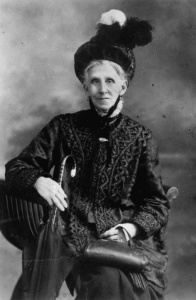Miller was born on 26 June 1839 at Chesterfield, Derbyshire, England, daughter of Daniel Holmes, a Unitarian cordwainer, and his wife Martha, née Hollingworth. Her father was a Chartist, and with Miller attending political meetings with her father as a young child, Miller connected the Queensland labour movement with the earliest days of British nineteenth century radicalism. Miller lived 40 years of her life in Derbyshire and Manchester until she migrated to Brisbane with her second husband in 1879. Seven years later (1886), Miller was to take the name of her third husband, Andrew Miller. In Brisbane Miller took the occupation of a shirtmaker, and 1890, at age 51, Miller joined the endeavour to form a female workers' union, mainly of tailoresses. The following year Miller provided evidence to the 1891 Royal Commission on Shops, Factories and Workshops of the Colony.
At this point, a new political life emerged for Miller at the time of the birth of the Australian Labor movement. Miller became the first woman to travel west organizing for the Australian Workers' Union during the aftermath of the Shearer’s Strike. Miller was the first woman member of the Brisbane Workers Political Organization, and foundation president of the Woman's Equal Franchise Association (1894-1905). In 1903 Miller became the President of the Women Workers Political Organisation. In 1908 she was one of two women to attend the Commonwealth Labor Conference. The odd high point in Miller’s career, making her something of a legendary figure, was the reputed account around the baton charge, led by of Queensland Police Commissioner, William Cahill, during the stand-off in Brisbane’s streets, in the 1912 General Strike. It was known that Cahill was thrown from his horse in the mêlée, the story developed that Miller struck Cahill’s horse with her hatpin.
The events of the Great War brought Miller into a different light. Biographer Pam Young stated that Miller’s “hatred of militarism led her to take an energetic part in the anti-conscription campaigns”. Miller was the President of the Queensland branch of the Women's Peace Army. At the ripe age of 77, Miller was a delegate to the Australian Peace Alliance Conference in Melbourne in 1916.
See Emma Miller on Scatterplot Matrix.
References
Young, Pam. 'Miller, Emma (1839–1917)', Australian Dictionary of Biography, National Centre of Biography, Australian National University, http://adb.anu.edu.au/biography/miller-emma-7583/text13241, published first in hardcopy 1986, accessed online 6 September 2015.


